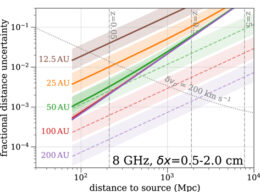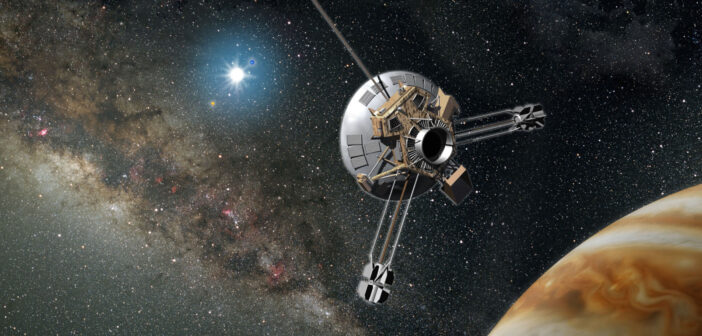Using a network of faraway telescopes in the outskirts of the solar system, astronomers could measure the distance to much farther away galaxies with exquisite precision. A recent study describes how this tactic works and explores what else we could learn with such a bold experiment.
Very, Very Long Baselines
Distance is notoriously a tricky quantity to measure in astrophysical contexts, and astronomers have struggled to size up the universe since Hubble first drew his famous diagram. While they have certainly made progress over the last century, it’s natural to wonder if modern technology could enable an entirely new, more precise way to measure the gaps between galaxies.

A sketch of three detectors and a fast radio burst source. Since the wavefront is slightly curved, the same emission will strike each detector at different times. Using measurements of those differences, astronomers can back out the distance to the source. [Boone and McQuinn 2023]
Such a mission would require solving numerous intense, but feasibly surmountable, engineering challenges. Chief among these, astronomers would have to know the distances between the telescopes to within just a few centimeters, a demanding requirement considering the millions of miles separating them and the many subtle forces that affect their motion. Also, each satellite would need to nurture an ultra-precise atomic clock in the face of the unforgiving vacuum of space. But, should engineers resolve these hindrances, a constellation of four or more telescopes drifting in the outer solar system could pin down the distance to each observed flash to within 1% uncertainty.
Spanning Distances and Disciplines

The uncertainty in a measurement of the distance to a source as a function of the true distance to the source for a number of different satellite configurations. Each color represents a different possible baseline separation, and the thickness of each region marks how the uncertainty changes if the resolution of their separation varies between 0.5 and 2 cm. Note that for a source closer than 100 megaparsecs (approximately 300 million light-years), a 25 AU baseline could measure its distance to better than 1%. [Boone and McQuinn 2023]
While this study may never grow into more than a thought experiment, such an exercise is constructive nonetheless and gives the astronomical community a chance to reflect on its current capabilities and muse about its future. That said, a more hopeful interpretation is to take this as a starting point for a grand, exacting, colossal mission that could one day uncover secrets of the universe, and our own backyard, all at once.
Citation
“Solar System-scale Interferometry on Fast Radio Bursts Could Measure Cosmic Distances with Subpercent Precision,” Kyle Boone and Matthew McQuinn 2023 ApJL 947 L23. doi:10.3847/2041-8213/acc947

